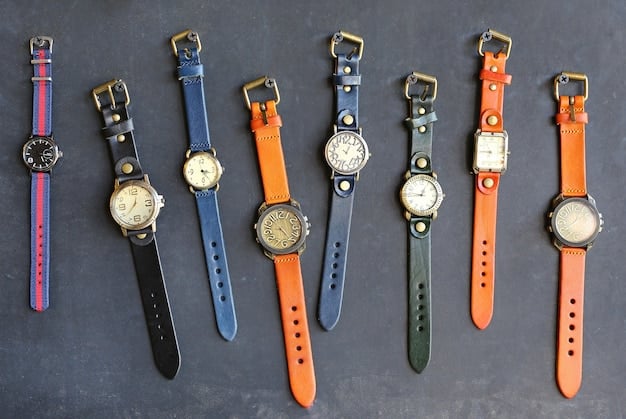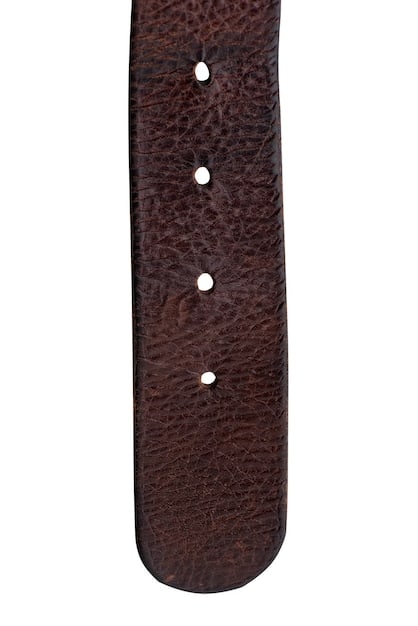How to Choose the Right Watch for Your Style: A Complete Guide

Choosing the right watch for your style involves considering various factors such as lifestyle, wrist size, personal taste, and the occasion for which the watch will be worn, ensuring it complements your overall appearance and reflects your personality.
Finding the perfect watch can feel overwhelming, but it doesn’t have to be. This guide will walk you through everything you need to know about how to choose the right watch for your style, ensuring you make a selection that complements your look and lifestyle.
Understanding Your Personal Style
Before diving into the world of watches, it’s essential to understand your personal style. This understanding serves as the foundation for choosing a timepiece that seamlessly integrates into your wardrobe and enhances your overall aesthetic.
Assessing Your Wardrobe
Take a look at your closet. What colors, patterns, and types of clothing do you gravitate towards? Understanding the predominant styles and colors in your wardrobe will help you choose a watch that complements your existing fashion choices.
Identifying Your Lifestyle
Your lifestyle plays a significant role in the type of watch that is most suitable for you. A watch should not only match your style but also be functional for your daily activities. Consider whether you lead an active lifestyle, work in a formal setting, or enjoy casual environments.
- Active Lifestyle: If you are active, consider a durable sports watch with features like water resistance and shock resistance.
- Formal Setting: For formal occasions, a classic dress watch with a leather strap and a simple dial is usually the best choice.
- Casual Environment: In casual settings, you have more flexibility. Explore watches with unique designs, colorful straps, or modern features.
Ultimately, your personal style is a reflection of who you are. Recognizing and understanding it is the first step toward finding a watch that not only tells time but also tells a story about you.
Considering Watch Types and Styles
The watch market is filled with different types, from classic analog to cutting-edge smartwatches. Each style caters to different needs and preferences, making it important to explore the options to find the best fit for your fashion and lifestyle.

Dress Watches
Dress watches are known for their elegant and understated design. They typically feature a simple dial, a slim profile, and a leather strap. These watches are designed to complement formal attire and are perfect for occasions where sophistication is key.
Sports Watches
Sports watches are built for durability and functionality. They often include features like chronographs, water resistance, and shock resistance. These watches are ideal for individuals who lead active lifestyles and require a timepiece that can withstand rigorous activities.
- Chronograph: Includes stopwatch functions, useful for timing activities.
- Diving Watch: Designed for underwater use, with high water resistance and a rotating bezel.
- Pilot Watch: Features a large, easy-to-read dial and often includes aviation-related functions.
Understanding the features of each watch type can help you make an informed decision based on your needs and preferences.
Matching Watch Size to Your Wrist
The size of your watch should be proportional to the size of your wrist. Wearing a watch that is too big or too small can throw off your overall look.
Measuring Your Wrist
Use a flexible measuring tape to measure the circumference of your wrist. Wrap the tape around your wrist just below the wrist bone, and record the measurement in inches or millimeters. This measurement will help you determine the ideal case diameter for your watch.
Understanding Case Diameter
The case diameter is the width of the watch face, typically measured in millimeters. For smaller wrists (6 inches or less), a case diameter of 34-38mm is usually suitable. For medium wrists (6 to 7 inches), a case diameter of 39-42mm works well. Larger wrists (7 inches or more) can handle watches with a case diameter of 44mm or larger.
- 34-38mm: Suitable for smaller wrists.
- 39-42mm: Ideal for medium-sized wrists.
- 44mm+: Best for larger wrists.
Consider also the lug width and the thickness of the watch case. A watch with a slim profile will generally look more elegant and complement a formal outfit, while a thicker watch can add a rugged touch to a casual look.
Choosing the Right Watch Band Material
The material of your watch band can significantly impact the watch’s overall appearance and comfort. Different materials offer different aesthetics and are suitable for various occasions.
Leather Bands
Leather bands are a classic choice for dress watches and formal occasions. They exude sophistication and elegance, making them a perfect complement to tailored suits and upscale attire. Leather bands come in various colors and finishes, allowing you to customize your look. Consider the quality of the leather; genuine leather will age beautifully and provide greater comfort over time.
Metal Bands
Metal bands, typically made of stainless steel, titanium, or gold, are durable and versatile. They are suitable for both casual and formal settings, depending on the design. Stainless steel bands are a popular choice for their durability and resistance to corrosion. Titanium bands are lightweight and hypoallergenic, making them a great option for those with sensitive skin. Gold bands add a touch of luxury and are often reserved for special occasions.

Other Band Materials
In addition to leather and metal, other band materials include nylon, rubber, and canvas. Nylon bands are durable and comfortable, making them ideal for sports watches and casual wear. Rubber bands are water-resistant and easy to clean, perfect for active lifestyles. Canvas bands offer a rugged and casual look, suitable for everyday wear.
- Nylon: Durable and comfortable for sports watches.
- Rubber: Water-resistant and easy to clean for active use.
- Canvas: Rugged and casual for everyday wear.
The choice of band material should align with your lifestyle and the occasions you plan to wear the watch. Consider factors such as comfort, durability, and style when making your decision.
Considering Dial Color and Design
The dial is the face of the watch and plays a crucial role in its overall appeal. The color and design of the dial can significantly impact the watch’s readability and style.
Classic White or Black Dials
White and black dials are timeless choices that offer versatility and legibility. A white dial provides a clean and crisp look, making it easy to read the time. A black dial exudes sophistication and can complement a wide range of outfits. Both colors are suitable for formal and casual settings.
Colorful Dials
For a more unique and expressive look, consider watches with colorful dials. Blue, green, and gray dials are popular choices that add a touch of personality to your wrist. These colors can complement various skin tones and wardrobe styles. Avoid overly bright or flashy colors if you prefer a more understated look.
- Blue Dials: Versatile and sophisticated, suitable for various settings.
- Green Dials: Adds a touch of nature and uniqueness.
- Gray Dials: Modern and understated, complements minimalist styles.
The design of the dial also matters. Simple and minimalist dials are easy to read and offer a timeless appeal. More intricate dials with multiple subdials and complications can add a technical and sophisticated touch.
Budget Considerations
Watches range widely in price, from affordable everyday timepieces to luxury investment pieces. Setting a budget before you start shopping can help you narrow down your options and find a watch that meets your needs without breaking the bank.
Entry-Level Watches
Entry-level watches offer great value for money and are perfect for those who are new to watch collecting. These watches typically feature reliable movements and durable materials, providing a solid foundation for everyday wear. Brands like Timex, Seiko, and Casio offer a wide range of entry-level watches that combine style and affordability.
Mid-Range Watches
Mid-range watches offer a step up in quality and features. These watches often include more intricate designs, higher-quality materials, and automatic movements. Brands like Tissot, Hamilton, and Citizen are popular choices in this category, offering a balance of luxury and value.
- Automatic Movements: Self-winding movements that are powered by the motion of your wrist.
- Sapphire Crystal: Scratch-resistant glass that protects the watch face.
Luxury watches represent the pinnacle of craftsmanship and design. These watches often feature precious metals, intricate movements, and exclusive features. Brands like Rolex, Omega, and Patek Philippe are synonymous with luxury and offer timepieces that can become treasured heirlooms.
| Key Aspects | Brief Description |
|---|---|
| ⏱️ Watch Size | Match watch size to your wrist for comfort and style. |
| 👔 Band Material | Choose leather for formal looks, metal for versatility. |
| 🎨 Dial Color | Opt for classic white/black or personal style colors. |
| 💰 Budget | Set a budget to guide your selection, from entry-level to luxury. |
Frequently Asked Questions
▼
For a small wrist (6 inches or less), a watch with a case diameter of 34-38mm is generally the most suitable. This size ensures the watch is proportional and doesn’t overwhelm the wrist, providing a comfortable and stylish fit.
▼
Consider your lifestyle and the occasions you’ll wear the watch. Leather bands are great for formal events, while metal bands are versatile. Rubber or nylon bands are ideal for active lifestyles due to their durability and water resistance.
▼
Classic white and black dials are the most versatile. They complement a wide range of outfits and are suitable for both formal and casual occasions, making them a staple in any watch collection.
▼
Water resistance is crucial, especially if you lead an active lifestyle or plan to wear the watch daily. A watch with at least 50 meters of water resistance can withstand splashes and brief immersion, while higher ratings are needed for swimming or diving.
▼
Consider the quality of materials, the movement type (quartz vs. automatic), and the brand reputation. Entry-level watches offer good value, while mid-range and luxury watches provide enhanced features and craftsmanship for a higher price.
Conclusion
Choosing the right watch for your style is a personal journey that involves understanding your preferences, lifestyle, and budget. By considering factors like watch type, size, band material, and dial design, you can select a timepiece that not only tells time but also enhances your overall appearance and reflects your individuality.





